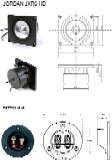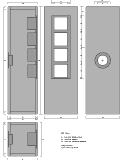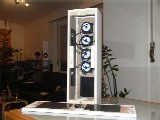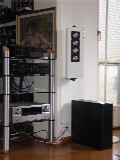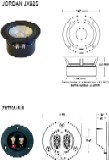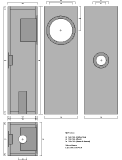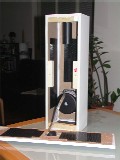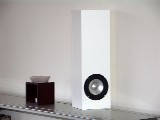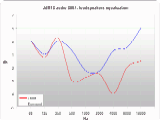Linear Arrays of Small Wide-range Drivers
Owning
Meridian D6000
digital active loudspeakers, I like their smoothness and exceptional dynamics,
but I find the medium a bit recessed and the trebble not so natural.
After some readings on the web, I decided to experiment building loudspeakers with
full-range drivers and integrate them in a surround setting.
Front speakers
The front speakers are based on a
E.J.Jordan
Linear Array of four
JXR6 HD
in a closed 8.4 liters box (Qtc= 0.78, Fc= 126 Hz) fully filled with a puffy polyester fleece (i.T. Sonofil).
The panels are damped by self-adhesive bitumen mats (Bitumex).
A pair of
TBI
Magellan VIII xu
provide the bass extension.
Because this system serves music only listening, a center channel is definitively not necessary.
Surround speakers
Surround speakers are
E.J.Jordan
JX92S
single drivers in 8.4 liters vented enclosures (tubular vent: 3.3 x 12 cm, Fb= 45 Hz)
filled with a polyester fleece, the port being left well cleared.
The inner surfaces are damped by bitumen mats.
Operating
A Denon
AVR-4306
surround receiver in a 4.1 configuration is used for equalization and amplification of the surround loudspeakers.
The front speakers are powered by two Denon POA-4400 150 W monoblocks (from the eighties) and the subwoofers by a
Palmer P1100LX 2 x 550 W powerhouse.
After Denon automatic set-up indications on distances and levels,
the system was tuned using the integrated 9 band octave equalizer.
The crossover frequencies are set at 120 Hz for front and 60 Hz for surround speakers.
The graph below (click to enlarge) shows the compensations for diffraction loss and room effects.
How it sounds
This is a high resolution system.
The line arrays act as sound projectors, partly because of their increased vertical directivity:
both in stereo and surround modes, imaging is very precise.
My wife appreciates, not only the slim design.
She finds it relaxed and when first auditioning, made classic comments like
"I never noticed the presence of this instrument" or "heard this sound on this recording before".
Links
SpeakerBuilding.com,
resource for DIY loudspeaker design and construction.
FullRangeDriver.com,
website by James Melhuish.
Design Guidelines for Practical NearField Line Arrays,
document, James R. Griffin, 2003.
OrdinaThor
website.
Michael LaLena DIY Audio & Video
website.
2007
 JdM12
JdM12